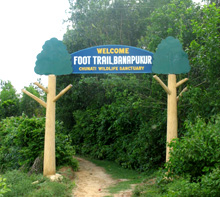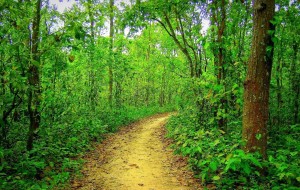USAID’s climate change activities in Bangladesh seek to improve energy sector performance through efficient energy and renewable energy use, and to improve management of natural resources such as water and tropical forests. The USAID Mission’s environment program has strengthened the capacity of the Bangladesh government and local non-governmental organizations to carry out these improvements.
USAID’s climate change activities in Bangladesh seek to improve energy sector performance through efficient energy and renewable energy use, and to improve management of natural resources such as water and tropical forests. The USAID Mission’s environment program has strengthened the capacity of the Bangladesh government and local non-governmental organizations to carry out these improvements. In Bangladesh, poverty and natural resource dependence is strongly linked as natural capital plays a critical role in the economy.
USAID assistance in environment contributes toward transformational diplomacy objectives by helping to protect and restore Bangladesh’s natural resources in a manner that simultaneously promotes livelihoods and economic growth for the rural poor, while introducing and advancing good governance practices.
Bangladesh is situated on the second largest river system in the world, which drains an area of 1,086,000 square kilometers from China, Nepal, India, and Bangladesh. This unique location results in annual flooding of approximately 50% of the country’s land area. At 150 million people and growing, gaps in policy and legislation, and conflicting institutional mandates, 90% of Bangladesh’s natural forests and 50% of its freshwater wetlands are lost or degraded. Degradation of natural capital and biodiversity has a serious and direct impact on the food security, nutrition and income of the poor. At the current pace, average temperatures are expected to rise between 1.1-6.4 degrees Celsius by 2100. Even a 2 degree Celsius temperature rise will submerge 20-22% of Bangladesh’s landmass, impacting 20-25 million people and increasing the frequency and severity of flooding.

USAID’s assistance focuses on conservation of natural resources and expanding broad-based economic opportunities. USAID has developed a model that devolves environmental management to local communities, whose lives are directly or indirectly dependent on natural capital. The communities “co-manage” the environment in conjunction with forest department officials. To date, USAID sponsored co-management projects have created a successful model of co-management in freshwater ecosystems and forests, but have had a relatively modest geographic coverage.
USAID’s goal over the next five years is to achieve recognition and acceptance of the co-management approach by the Government of Bangladesh (GOB) and integration of co-management into the government’s management tactics. Integrated activities will result in: 1) development of a co-management strategy that applies to all ecosystems, including those outside freshwater and forest ecosystems; 2) over 50 protected areas managed with USAID assistance directly benefiting two and a half million people; 3) GOB approval to share park fees with local communities to finance conservation efforts and support eco-friendly jobs development; and 4) an additional 350,000 hectares co-managed by communities and the GOB. Achievement of these results will provide direct economic benefit to 500,000 rural poor, supporting USAID’s strategy of pro-poor economic growth. In addition, these results are expected to have a multiplier effect on Bangladesh’s overall conservation efforts, promoting climate change mitigation through improved land use and adaptation to climate change-related vulnerabilities by communities, as well as the GOB.
The energy sector in Bangladesh is mostly publicly owned and managed, exhibiting very high levels of inefficiency that increase greenhouse gas emissions. To reduce these emissions, USAID encourages the use of natural gas, a source of clean energy, and the reduction of energy demands through renewable energy solutions.
Official management plans have been approved and are being implemented to give these Councils and the 235,000 people they represent a permanent voice in both conserving and benefiting from the Protected Forest Areas. The quality of Protected Areas has improved in visible, tangible ways: trails, information kiosks and interpretive information is present at all pilot sites; forests that were slowly disappearing are now returning to health; and key measured indicator species are proving that the forest is returning.
The improvements in such important resources have spurred increased economic opportunities that benefit the poor. Conservation enterprises have expanded, including eco-cottages, eco-guides, export quality handicrafts, sales of informational materials at Protected Area entries. And now, most recently, the Government has approved the principle of sharing entry fees to all pilot PAs with the Councils that are co-managing them. The USAID “Nishorgo” effort can be interpreted as a conglomeration of conservation efforts leading to important economic opportunities, namely the conservation of carbon through protection of woody biomass and the increased production of biomass.
Energy Efficiency and Sourcing of Clean and Renewable Energy
Through advocating the “unbundling” or transfer of state monopoly assets to specialized transmission and distribution companies, USAID is improving the performance of the national power generation and distribution system and reducing systemic losses by ensuring greater accountability and transparency.
Continued assistance in rural electrification has further strengthened the overall Bangladesh rural electrification program, which is based on the U.S. rural electric cooperative model. This assistance to the Rural Electrification Board (REB) and the 70 rural electric cooperatives that distribute electricity in rural Bangladesh has resulted in increased legal power connections.
Project Highlights
USAID placed a strong emphasis on joint forestry patrols between the Forestry Department and the local community for the Nishorgo project, allowing for greater awareness regarding illegal logging activities. Additionally, USAID has offered training programs for junior to mid-level forest officers on protected area co-management.
Based on the success of Grameen Shakti’s Renewable Energy Program, USAID is currently funding its initiative for “Rural Empowerment through Renewable Energy Project.” The project will develop women’s direct employment as well as empower their socio-economic base, while further promoting the expansion of climate-friendly energy uction in the future.



